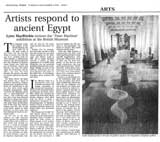| |
|
 |
 |
 |
 |
 |
|
Artists Respond to Ancient Egypt
Lynn MacRitchie reviews the 'Time Machine' exhibition at the British Museum.
by Lynn MacRitchie, Financial Times, December 6, 1994.
The Egyptian sculpture gallery of the British Museum has been called one of the great rooms of the world.
For the last few weeks 12 artists have had the run of it, creating work for Time Machine, a collaboration between
the British Museum and the Institute of International Visual Arts. Until the end of February visitors will discover
not only the thrillingly old civilization and its relics, but also the links between the ancient and modern worlds
explored by the new works.
For Henry Moore, the Egyptian Gallery was a source of profound inspiration. Contemplating these magnificent fragments,
he realized that it was not size alone which made sculpture monumental. "What I found in the Egyptian pieces was a
monumentality of vision". The craftsmen who gave this vision form laboured together in a great work of glorification,
of their kings and of their gods. Many devoted their lives to this task; they lived in villages near the sites of the
royal tombs, passed on their positions to their sons, and were themselves buried in decorated vaults.
At the end of the 20th century, no such supreme vision requires the subjection of individual craft or skill to a total
world view. Instead, we live in a world of constant questioning, where the boundaries of society shimmer and shift.
The responses of the artists to the challenge set them by James Putnam, curator in the Egyptian department, who had
the idea for the show, could not have been more varied.
Stephen Cox, for example, has long been devoted to finding and carving the rare, hard stones favoured by the Pharaohs,
and ‘Flask" made in 1991, sits in elegant harmony beneath a statue of King Amenophis III of 1400 B. C.. Kate Whiteford,
too, has produced paintings brimming with confidence, finding an echo of her habitual resonating red and green pigments
still visible on the false door of Ptahshepes, transition point between life and death.
Igor Mitoraj works in a monumental style, his sculptural technique and images dependent on ancient and classical
predecessors but presented with a questioning, surrealist twist. Marc Quinn has reprised the Perspex cast of his head,
which became infamous when filled with his blood, to make a refrigerated receptacle for a hibernating frog. An Egyptian
symbol of birth, it seems to be snoozing peacefully despite the bright lights and fascinated onlookers.
Rita Keegan has brought her own family history to set beside that of the ancient gods, choosing a deity of fertility to
guard the video screen on which images of her mother and father are mixed with those of the Old Kingdom pair statue of
Kaitep and Hetepheres of 2300 B. C.. David Hiscock takes us into the world of the supermarket by transforming the Rosetta
Stone into a bar code, and introduces a touch of modern day idol worship by photographing "the hands of sculptor Kiki
Smith wearing ancient rings".
These late 1990s symbols of consumerism and fame seem oddly touching among so much ancient magnificence. Only Alexander
Mihaylovich seems to have lost his head completely in the face of such tough competition. His huge painting/construction
"Reconstruction" towers above everything else in a piece of kitsch Las Vegas style scene-stealing which only confirms
Moore’s wise words about size.
Present as a photograph only is the installation made from 30 tons of golden sand which Andy Goldsworthy created
specially for the exhibition over one weekend, but which could not be allowed to remain in a gallery tramped through
by seven million visitors a year. Goldsworthy frequently creates ephemeral pieces outdoors, which are photographed and
left for nature to reclaim. This time, for those of us lucky enough to see it before its removal, the snaking golden
form brought a symbol of the energy of creation into the heart of the gallery, drawing the great relics together in
its coils. Its unique setting gave the sand an added dimension. For a few brief hours, the graven image of the ancient
rulers of Egypt, isolated in their London magnificence, once more lorded over the desert from whence they came.
|
 |
| |
 |
 |
|
|